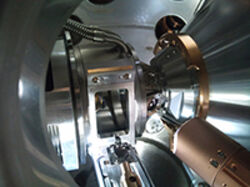Ambient pressure XPS
Summary

Electron spectroscopy has provided much of our current knowledge on the chemical and physical processes involved in the complex interactions between a solid surface and its surroundings. Such processes are for example important for surface catalysis, corrosion and thin film growth.
As the surface state depends strongly on its environment, it is vital that such studies are performed under realistic in situ and/or operando conditions. Recently, ambient pressure x-ray photoelectron spectroscopy (APXPS) has been introduced as a powerful method to approach such questions due to the sensitivity to the chemical state of the substrate as well as of the adsorbates. Whereas it is not possible to perform electron spectroscopy at realistic pressures for e.g. industrial catalytic reactions, the attainable pressures in the range of 0.01 to of ca. 30 mbar are in most cases sufficient for modelling real reaction conditions.
The HIPPIE and SPECIES beamlines at the MAX IV Laboratory are key infrastructure for this project, and our main research focuses are catalysis, thin film growth (atomic layer deposition, ALD, and chemical vapour deposition, CVD) and chemistry below graphene.
Background
During the past years we have built up a new activity focused on the use of x-ray photoelectron spectroscopy for in situ and operando surface science studies. In particular, we have built up the Swedish ambient pressure x-ray photoelectron spectroscopy instrumentation at the MAX IV Laboratory. We are involved with both the HIPPIE and SPECIES beamlines.
While traditional x-ray photoelectron spectroscopy is limited to vacuum environments of 10-6 mbar and better, the technical development of ambient pressure x-ray photoelectron spectroscopy, driven forward in particular by groups in Berlin and Berkeley (Bluhm, Schlögl, Salmeron et al.), allows the measurement of x-ray photoelectron spectroscopy at maximum pressures of around 1 to 10 mbar. Such a pressure is sufficiently high to allow the study of the influence of a gas phase chemical potential on the state and dynamic development of a surface, and completely new perspectives are opened up for the use of surface scientific methods.
The instruments at the HIPPIE and SPECIES beamlines enable the dual use of ultrahigh vacuum x-ray and ambient pressure x-ray photoelectron spectroscopy on the very same sample. This is made possible by the use of dedicated ambient pressure cells in an ultrahigh vacuum environment. These cells also allows the fast switching of gas composition, a feature which is highly favourable for the study of chemical reactions at surfaces. In addition, further sample enviroments for the study of e.g. liquids and electrochemical systems are available, and we work on the realisation of additional sample environments e.g. for the study of thin film growth.
The primary focus of our in situ studies is the investigation of thin film growth by atomic layer deposition (ALD) and chemical vapour deposition (CVD) as well as the study of catalytic samples and processes. We study both surface-supported metal element nanoparticles, oxide films, and transition metal complexes. A very important goal is to widen our perspective and to study more complex surfaces and reactions.
The real-time monitoring of ALD project is in collaboration with the LPC-MR group at Université Sorbonne in Paris, with whom we also collaborate on the development of instrumentation for ambient pressure x-ray photoelectron spectroscopy.
Interested in working with us?
Available BSc/Msc projects
We welcome candidates for BSc and MSc thesis.
PhD and PostDoc positions
When available published on Lund University's website. Direct contact is welcome.
